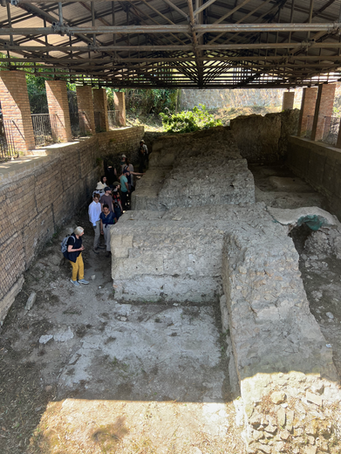History

In Antiquity
In the Middle Ages and Early Modern Period
In Recent Years
In the Republican period (509 B.C.E. to 27 B.C.E), the archaeological site was the highest point of the Little Aventine, a southern spur of Rome’s better-known Aventinus Major Hill– one of seven hills on which ancient Rome was built. Also referred to as the saxum, Little Aventine was a strategic point to control the valley of the Circus Maximus and the routes to the Eastern coast and the South of Italy. We can recognize the importance of Little Aventine given its inclusion within the Servian Walls, which were built as a defensive barrier for ancient Rome. Today, parts of the Servian Walls, which variously date to between the 6th to 4th Century BCE, run through the archaeological site—some in the garden of the Istituto Santa Margherita and others inside the Istituto’s main building itself. Beginning in the early Imperial Period, the saxum was inhabited by the private homes of elite and imperial families, including a certain Lucius Fabius Cilo, who was consul in both 193 and 204 CE. As documented by the 4th century CE Regionary Catalogs, the neighborhood was a dense urban area, and the hill included the barracks of a cohort of the vigiles, elite houses, bath complexes, warehouses, and the later Aurelian Walls.
While not much is known about the site during this period, it appears to have become land owned, used and shared by the church and local farmers. La Nuova Topografia di Roma, a map that was surveyed and engraved by Giambattista Nolli in 1748 shows that this land became vineyards at some point during this period and remained vineyards for a few centuries as indicated by the earlier map by Bufalini in 1551. One thing we do know about this site during this period was that the Aventine Hill became a significant monastic and religious center, with the Basilica of San Saba playing a central role. The monastery at San Saba served as a hub for diplomatic activity between Rome, Constantinople, and the world. Interestingly, San Saba was founded by a persecuted Christian Monk from Palestine, and now the area serves as the site for the Embassy of Palestine, continuing its role as a place of diplomatic relations. The Basilica of Santa Balbina, which lies within the Aventinus Minor Project site is one of the original twenty-five titular churches of Rome. In the 19th Century, the Congregation of the Franciscan Sisters of the Sacred Heart acquired the courtyard and convent of the Basilica Santa Balbina and founded the Istituto Santa Margherita, which has become one of AMP’s greatest partners.
After the unification of Italy in the 1860s and the establishment of Rome as its new capital, the landscape began to change as the population more than tripled from 400,000 in 1901 to 1,500,000 by 1951. With mass migration from the North to Rome, the Aventinus Minor area experienced a housing development spur to house the new residents in Rome— what was once vineyards was now a residential area with apartments and public buildings. During the Fascist period (1922-1943), the site was used for the construction of the New Ministry of Italian Africa, which was later converted to the Food and Agriculture Organization of the United Nations (FAO). Today, this area is still very active and inhabited by both the grandchildren of those mentioned in the WWII inscriptions as well as professionals who work in the various international organizations in the area, including FAO. The archaeological site is located specifically in the garden that was part of the Monastery of Santa Balbina and is now the Istituto of Santa Margherita, a convalescent home that helps the formerly unhoused population. AMP aims to bring this garden back to life and share it with those who have a curiosity to learn more about the history and importance of this site.

La Nuova Topografia di Roma
Giambattista Nolli (1748)

Site Timeline
.png)
Today
1980s
1938-1952
1879
1871
15th - 16th c.
CE
Post 6th c. CE
499 CE
4th c. CE
175-225 CE
1st-4th
c. CE
1st c. BCE - 1st c. CE
6th - 1st
c. BCE
6th - 4th
c. BCE
.png)
*The timeline's dates are provisional and based on research completed in 2025




